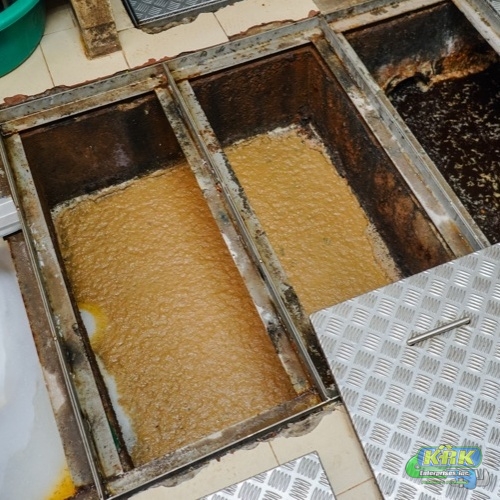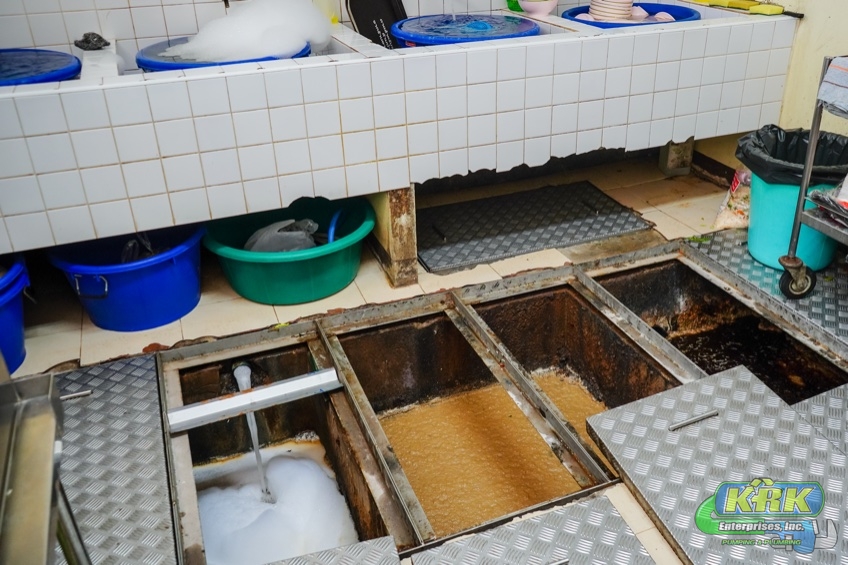
Learning About Grease Traps
Before we dive in to answer what happens if you don’t have one, let’s review what is a grease trap. A grease trap is a container that kitchen wastewater drains through and catches the FOG before it gets into the drainage system. It traps the FOG and only allows clear water to proceed to the drainage system.
So, if you’re not in the restaurant business or plumbing industry, you may not be familiar with what FOG is referring to. FOG = Fats Oil Grease. All of these are common in kitchens where large amounts of food are cooked. This can be a hospital, factory or industry, hospitals, schools, public restaurants, or any structure where large amounts of food are cooked.
Are grease traps required?
A grease trap is recommended, and in most cities and counties, they are required to pass inspection. In Port St. Lucie, Florida, any facility that has the activity of cooking in grease or oil is required to have a grease trap system. This includes cafeterias, restaurants, cafeterias, food-processing plants, etc.
Are grease traps for houses?
Typically, no, they are not standard, however, it can be beneficial for a home that does a lot of cooking to have a grease trap installed. Think of television reality shows with households that have a large number of kids, or a residential structure with an above-normal number of residents.
Is a grease trap attached to other kitchen equipment?
Because commercial kitchens flush out large amounts of wastewater every day that contains FOG, the drain lines, and sewage system can get backed up. A grease trap is attached to the drain line, looks like a box on the outer wall.
Once the wastewater and FOG get to the box, baffle chambers sort the FOG from the wastewater and the wastewater flows on while the FOG from the wastewater. And the grease trap “traps” the FOG that is floating on the surface, while the heavier particles sink to the bottom.
A grease trap cannot be attached or connected anywhere other than the drain line. They cannot be attached to the dishwasher, grinders, or other common kitchen equipment or fixtures.
Why should my restaurant have a grease trap?
FOG, as it is referred to in the kitchen industry, Fat Oil Grease, may seem harmless, but they aren’t. With FOG, if you pour into a drain while in its liquid state, it sticks to the sides of the drainpipe. There, it cools down and solidifies. Then everything else you pour down the drain sticks to that and in a matter of time, you have a blocked drain line.
Any kitchen that is on a septic system will experience the same thing, and more! Furthermore, when Fats, Oil, and Grease are poured into the kitchen drain, it is released into the septic drain field and into the environment. At this point, it becomes a public health hazard. With a properly installed grease trap, whether your facility is on a sewer system or septic system, the FOG is trapped and keeps the drain lines open.

Do you have to clean your grease trap?
Kitchen managers and restaurant owners have many responsibilities, and that includes cleaning a grease trap. Like your home air filter can be easily overlooked, so can cleaning the grease trap with all the other tasks at hand.
This is why it is recommended that a kitchen manager or restaurant owner pair up with a grease trap company and set up a specific schedule. They can assist in determining the frequency by the capacity of the grease trap and the seating capacity of the institution. The standard schedule is monthly, but there is the ‘one-fourth’ rule, meaning when the grease trap is at one-fourth its capacity, it is time for it to be cleaned.
Do you have to manually empty a grease trap?
You can, but most restaurants have a grease trap service. Manually cleaning one is smelly and messy, but if you’re trying to save money, do this first thing in the morning before you you’re your kitchen and follow these basic steps:
- Gently and slowly remove the lid from the grease trap.
- Measure the level of the grease using a ruler and write that number on the EPA report sheet. You’ll need this information when the health inspector comes by.
- Remove any water from the grease trap using a small pump and bucket, then set the bucket to the side.
- Scoop the grease out of the trap and place the FOG in another bucket.
- Be sure to scrape the bottom and sides and scrap the lid clean of any excess grease. The more you get out, the longer it will be before you have to do this again.
- Next, scrub all the grease trap parts and flush the screens.
- Pour the water you removed earlier back into the grease trap.
- Reinstall the parts you have removed and replace the lid.
What happens if you don’t have a grease trap?
There are 3 reasons why you shouldn’t ignore having your grease trap cleaned on a regular basis:
1. ENVIRONMENT AND HEALTH RISK
A grease trap prevents blockage and eliminates foul odors. The bacteria created by FOG can make employees ill.
2. PLUMBING ISSUES
A blockage caused by FOG happens when the grease trap isn’t cleaned regularly, resulting in sewage backup and more.
3. GREASE TRAP MAINTENANCE
Your local government can charge your restaurant with fines. If you allow FOG to be poured into the drains, it can cause severe plumbing issues that will cost money to repair and could shut your kitchen down.
Closing Question: Do grease traps need to be replaced?
Yes, and that is another benefit to having a professional grease trap cleaning service! They will advise you when your current grease trap is ready to be replaced. Typically, when your grease trap has been cleaned on a regular schedule and is still emitting a foul odor, it is time for a new grease trap.
KRK Enterprises, Inc. is here to help with your grease trap in Fort Pierce and Port St. Lucie, Fl. Call 800-330-7686 today for services.

